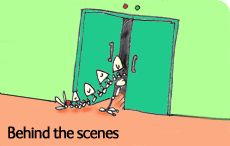Other invertebrates
Invertebrates (animals without backbones) make up the majority of animals on Earth, with many millions of species exploiting the sky, sea, land…and even the insides of other animals. Find out about the good, the bad and the ugly, as we reveal the little-known worlds of some of these fascinating creatures.
-

Blaschka models of marine invertebrates
Rotate a stunning glass model of a radiolarian, a type of plankton, created in the 19th century by the famous artisans Leopold and Rudolf Blaschka and view more of their exquisite models in our slideshow.
-

Discovery of North Sea marine worm
Find out about the marine worm Osedax mucofloris (which means bone-eating snot-flower) that was found in one of the best-studied marine environments on the planet, the shallow waters of the North Sea.
-

Preparation of giant squid video
Watch the Natural History Museum's scientists at work, preparing the 8.62m-long giant squid for storage, in this video.
-

Chinese mitten crabs
The Chinese mitten crab is having a significant impact on our environment. Find out why, and how you can help scientists record their invasion.
-

British earthworms
There are more than 25 species of earthworm in Britain. Browse images of the more common ones and find out why they are so good for soil.
-

British earthworm survey
Find out how you can help scientists learn more about the distribution of British earthworm species and the soil they live in.
-

Mite specimens
Zoom in on stunning magnified images of mites and come face to face with the creepy crawlies sharing your home.
-

Mite CT scan
Take a look at the cutting-edge technology that allows scientists to study specimens, like this mite, without having to dissect or damage them, and learn more about our mite research.
-

The Echinoid Directory
Use our illustrated key to identify sea urchins and their relatives and explore how they live, along with a brief history of the group.
-

Specimen jar
Rotate our virtual specimen jar, and view brachiopods collected during the HMS Challenger expedition from 1872 to 1876.
-

Land snail
A. haemastoma is a large and beautiful snail only found in Sri Lanka. Take a 360 degree look by rotating our virtual object’s shell.
-

Woodlouse identification key
This simple key will help you to identify the woodlice that you are most likely to find.
-

Fate of coral reefs
Watch the video to find out why carbon dioxide emission levels need to be limited if we are to avoid the extinction of tropical coral reefs.
-

The secret life of barnacles
Barnacles are not only zoologically fascinating but are also economically important. Find out how and why with zoologist Phil Rainbow.
Toolbox

The first collected specimen of Theobroma cacao, the plant from which chocolate is made, is kept in the Museum.
